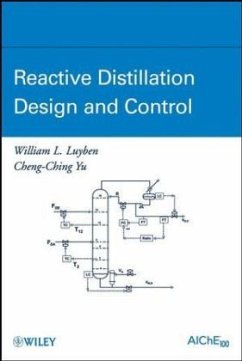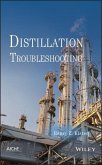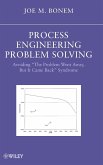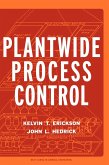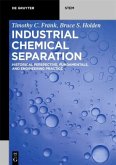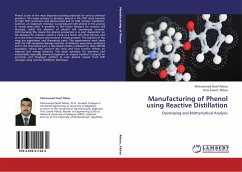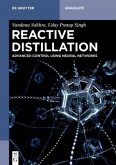- Gebundenes Buch
- Merkliste
- Auf die Merkliste
- Bewerten Bewerten
- Teilen
- Produkt teilen
- Produkterinnerung
- Produkterinnerung
Reactive distillation has economical and environmental advantages
Reactive distillation is a breakthrough process innovation with numerous applicationsin the petroleum and chemical industries. In systems with the appropriate chemistryand vapor-liquid phase equilibrium, it combines the reaction and separation operations,which reduces energy and capital costs and environmental impact. After an overview of the fundamentals, limitations, and scope of reactive distillation, Reactive Distillation Design and Control: _ Uses rigorous models for steady-state design and dynamic analysis of different…mehr
Andere Kunden interessierten sich auch für
![Distillation Troubleshooting Distillation Troubleshooting]() Henry Z. KisterDistillation Troubleshooting162,99 €
Henry Z. KisterDistillation Troubleshooting162,99 €![Process Engineering Problem Solving Process Engineering Problem Solving]() J. M. BonemProcess Engineering Problem Solving130,99 €
J. M. BonemProcess Engineering Problem Solving130,99 €![Plant-Wide Process Control Plant-Wide Process Control]() Kelvin T. EricksonPlant-Wide Process Control236,99 €
Kelvin T. EricksonPlant-Wide Process Control236,99 €![Industrial Chemical Separation Industrial Chemical Separation]() Timothy C. FrankIndustrial Chemical Separation95,99 €
Timothy C. FrankIndustrial Chemical Separation95,99 €![Distillation Distillation]() Alfons VogelpohlDistillation39,95 €
Alfons VogelpohlDistillation39,95 €![Manufacturing of Phenol using Reactive Distillation Manufacturing of Phenol using Reactive Distillation]() Mohammed Nsaif AbbasManufacturing of Phenol using Reactive Distillation47,99 €
Mohammed Nsaif AbbasManufacturing of Phenol using Reactive Distillation47,99 €![Reactive Distillation Reactive Distillation]() Vandana SakhreReactive Distillation56,99 €
Vandana SakhreReactive Distillation56,99 €-
-
-
Reactive distillation has economical and environmental advantages
Reactive distillation is a breakthrough process innovation with numerous applicationsin the petroleum and chemical industries. In systems with the appropriate chemistryand vapor-liquid phase equilibrium, it combines the reaction and separation operations,which reduces energy and capital costs and environmental impact. After an overview of the fundamentals, limitations, and scope of reactive distillation, Reactive Distillation Design and Control:
_ Uses rigorous models for steady-state design and dynamic analysis of different types of reactive distillation columns
_ Quantitatively compares the economics of reactive distillation columns with conventional multi-unit processes
_ Goes beyond traditional steady-state design that considers primarily the capital investment andenergy costs when analyzing the control structure and the dynamic robustness of disturbances
_ Discusses how to maximize the economic and environmental benefits of reactive distillation technology
Written by authors who have a background in design and control with an emphasis on practical engineering solutions to real industrial problems, this guide forgoes intricate, complicated mathematics and complex methods of analysis and gets down to business. It's an accessible reference for chemical, process, and petroleum engineers and undergraduate and graduate students in chemical engineering.
Hinweis: Dieser Artikel kann nur an eine deutsche Lieferadresse ausgeliefert werden.
Reactive distillation is a breakthrough process innovation with numerous applicationsin the petroleum and chemical industries. In systems with the appropriate chemistryand vapor-liquid phase equilibrium, it combines the reaction and separation operations,which reduces energy and capital costs and environmental impact. After an overview of the fundamentals, limitations, and scope of reactive distillation, Reactive Distillation Design and Control:
_ Uses rigorous models for steady-state design and dynamic analysis of different types of reactive distillation columns
_ Quantitatively compares the economics of reactive distillation columns with conventional multi-unit processes
_ Goes beyond traditional steady-state design that considers primarily the capital investment andenergy costs when analyzing the control structure and the dynamic robustness of disturbances
_ Discusses how to maximize the economic and environmental benefits of reactive distillation technology
Written by authors who have a background in design and control with an emphasis on practical engineering solutions to real industrial problems, this guide forgoes intricate, complicated mathematics and complex methods of analysis and gets down to business. It's an accessible reference for chemical, process, and petroleum engineers and undergraduate and graduate students in chemical engineering.
Hinweis: Dieser Artikel kann nur an eine deutsche Lieferadresse ausgeliefert werden.
Produktdetails
- Produktdetails
- Verlag: Wiley & Sons
- 1. Auflage
- Seitenzahl: 608
- Erscheinungstermin: 1. Oktober 2008
- Englisch
- Abmessung: 251mm x 185mm x 36mm
- Gewicht: 1172g
- ISBN-13: 9780470226124
- ISBN-10: 0470226129
- Artikelnr.: 24620998
- Herstellerkennzeichnung
- Libri GmbH
- Europaallee 1
- 36244 Bad Hersfeld
- gpsr@libri.de
- Verlag: Wiley & Sons
- 1. Auflage
- Seitenzahl: 608
- Erscheinungstermin: 1. Oktober 2008
- Englisch
- Abmessung: 251mm x 185mm x 36mm
- Gewicht: 1172g
- ISBN-13: 9780470226124
- ISBN-10: 0470226129
- Artikelnr.: 24620998
- Herstellerkennzeichnung
- Libri GmbH
- Europaallee 1
- 36244 Bad Hersfeld
- gpsr@libri.de
William L. Luyben, PHD, is Professor of Chemical Engineering at Lehigh University. In addition to forty years of teaching, Dr. Luyben spent nine years as an engineer with Exxon and DuPont. He has written nine books and more than 200 papers. He was the 2004 recipient of the Computing Practice Award from the CAST Division of the AIChE and was elected in 2005 to the Process Automation Hall of Fame. CHENG-CHING YU, PHD, has spent sixteen years as a Professor at National Taiwan University of Science and Technology and four years at National Taiwan University. He has published over 100 technical papers in the areas of plant-wide process control, reactive distillation, control of microelectronic processes, and modeling of fuel cell systems.
Preface xvii
1 Introduction 1
1.1 History 2
1.2 Basics of Reactive Distillation 3
1.3 Neat Operation Versus Excess Reactant 7
1.4 Limitations 8
1.4.1 Temperature Mismatch 8
1.4.2 Unfavorable Volatilities 9
1.4.3 Slow Reaction Rates 9
1.4.4 Other Restrictions 9
1.5 Scope 9
1.6 Computational Methods 10
1.6.1 Matlab Programs for Steady-State Design 10
1.6.2 Aspen Simulations 10
1.7 Reference Materials 11
Part I Steady-State Design of Ideal Quaternary System 15
2 Parameter Effects 17
2.1 Effect of Holdup on Reactive Trays 20
2.2 Effect of Number of Reactive Trays 22
2.3 Effect of Pressure 24
2.4 Effect of Chemical Equilibrium Constant 27
2.5 Effect of Relative Volatilities 29
2.5.1 Constant Relative Volatilities 30
2.5.2 Temperature-Dependent Relative Volatilities 30
2.6 Effect of Number of Stripping and Rectifying Trays 32
2.7 Effect of Reactant Feed Location 33
2.7.1 Reactant A Feed Location (NFA) 33
2.7.2 Reactant B Feed Location (NFB) 35
2.8 Conclusion 36
3 Economic Comparison of Reactive Distillation with a Conventional Process
37
3.1 Conventional Multiunit Process 38
3.1.1 Assumptions and Specifications 38
3.1.2 Steady-State Design Procedure 40
3.1.3 Sizing and Economic Equations 42
3.2 Reactive Distillation Design 43
3.2.1 Assumptions and Specifications 44
3.2.2 Steady-State Design Procedure 45
3.3 Results for Different Chemical Equilibrium Constants 47
3.3.1 Conventional Process 47
3.3.2 Reactive Distillation Process 54
3.3.3 Comparisons 61
3.4 Results for Temperature-Dependent Relative Volatilities 61
3.4.1 Relative Volatilities 62
3.4.2 Optimum Steady-State Designs 64
3.4.3 Real Chemical Systems 69
3.5 Conclusion 70
4 Neat Operation Versus Using Excess Reactant 71
4.1 Introduction 72
4.2 Neat Reactive Column 72
4.3 Two-Column System with Excess B 75
4.3.1 20% Excess B Case 76
4.3.2 10% Excess B Case 78
4.4 Two-Column System with 20% Excess of A 81
4.5 Economic Comparison 85
4.6 Conclusion 86
Part II Steady-State Design of Other Ideal Systems 87
5 Ternary Reactive Distillation Systems 89
5.1 Ternary System without Inerts 90
5.1.1 Column Configuration 90
5.1.2 Chemistry and Phase Equilibrium Parameters 90
5.1.3 Design Parameters and Procedure 92
5.1.4 Effect of Pressure 94
5.1.5 Holdup on Reactive Trays 94
5.1.6 Number of Reactive Trays 94
5.1.7 Number of Stripping Trays 94
5.2 Ternary System with Inerts 99
5.2.1 Column Configuration 99
5.2.2 Chemistry and Phase Equilibrium Parameters 99
5.2.3 Design Parameters and Procedure 100
5.2.4 Effect of Pressure 102
5.2.5 Control Tray Composition 103
5.2.6 Reactive Tray Holdup 105
5.2.7 Effect of Reflux 107
5.2.8 Chemical Equilibrium Constant 109
5.2.9 Feed Composition 109
5.2.10 Number of Reactive Trays 113
5.2.11 Number of Rectifying and Stripping Trays 113
5.3 Conclusion 116
6 Ternary Decomposition Reaction 119
6.1 Ternary Decomposition Reaction: Intermediate-Boiling Reactant 120
6.1.1 Column Configuration 120
6.1.2 Chemistry and Phase Equilibrium Parameters 120
6.1.3 Design Parameters and Procedure 121
6.1.4 Holdup on Reactive Trays 123
6.1.5 Number of Reactive Trays 124
6.1.6 Number of Rectifying and Stripping Trays 126
6.1.7 Location of Feed Tray 126
6.2 Ternary Decomposition Reaction: Heavy Reactant with Two-Column
Configurations 127
6.2.1 Column Configurations 127
6.2.2 Chemistry and Phase Equilibrium Parameters 128
6.2.3 Design Parameters and Procedure 128
6.2.4 Reactive Holdup 129
6.2.5 Number of Reactive Trays 131
6.2.6 Number of Rectifying Trays 132
6.3 Ternary Decomposition Reaction: Heavy Reactant with One-Column
Configurations 134
6.3.1 Feasibility Analysis 134
6.3.2 Column Configuration 139
6.3.3 Design Parameters and Procedure 139
6.3.4 Reactive Tray Holdup 139
6.3.5 Number of Reactive Trays 139
6.3.6 Number of Rectifying Trays 140
6.3.7 Location of Feed Tray 143
6.3.8 Comparison Between These Two Flowsheets 143
6.4 Conclusion 143
Part III Steady-State Design of Real Chemical Systems 145
7 Steady-State Design for Acetic Acid Esterification 147
7.1 Reaction Kinetics and Phase Equilibria 147
7.1.1 Reaction Kinetics 147
7.1.2 Phase Equilibria 149
7.2 Process Flowsheets 153
7.2.1 Type I Flowsheet: MeAc 153
7.2.2 Type II Flowsheet: EtAc and IPAc 156
7.2.3 Type III Flowsheet: BuAc and AmAc 157
7.3 Steady-State Design 158
7.3.1 Design Procedure 158
7.3.2 Optimized Design 160
7.4 Process Characteristics 168
7.4.1 Type I: MeAc 168
7.4.2 Type II: EtAc and IPAc 168
7.4.3 Type III: BuAc and AmAc 170
7.5 Discussion 175
7.6 Conclusion 177
8 Design of Tame Reactive Distillation Systems 179
8.1 Chemical Kinetics and Phase Equilibrium 180
8.1.1 Chemical Kinetics 180
8.1.2 Phase Equilibrium Using Aspen Plus 181
8.1.3 Conceptual Design 186
8.2 Component Balances 194
8.3 Prereactor and Reactive Column 195
8.3.1 Base Case Design of Reactive Column 195
8.3.2 Effect of Design Parameters on Reactive Column 199
8.4 Pressure-Swing Methanol Separation Section 208
8.5 Extractive Distillation Methanol Separation Section 209
8.6 Economic Comparison 210
8.7 Conclusion 212
9 Design of MTBE and ETBE Reactive Distillation Columns 213
9.1 MTBE Process 213
9.1.1 Phase Equilibrium 214
9.1.2 Reaction Kinetics 214
9.1.3 Aspen Plus Simulation Issues 214
9.1.4 Setting up the Aspen Plus Simulation 215
9.1.5 Effect of Design Parameters 221
9.1.6 Chemical Equilibrium Model 229
9.2 ETBE Process 231
9.2.1 Kinetic Model 231
9.2.2 Process Studied 232
9.2.3 User Subroutine for ETBE 232
9.2.4 Chemical Equilibrium Model 234
9.2.5 Effects of Design Parameters 236
9.3 Conclusion 237
Part IV Control of Ideal Systems 239
10 Control of Quaternary Reactive Distillation Columns 241
10.1 Introduction 242
10.2 Steady-State Design 243
10.3 Control Structures 245
10.4 Selection of Control Tray Location 246
10.5 Closed-Loop Performance 247
10.5.1 CS7-R Structure 247
10.5.2 CS7-RR Structure 248
10.6 Using More Reactive Trays 249
10.6.1 Steady-State Design 249
10.6.2 SVD Analysis 250
10.6.3 Dynamic Performance of CS7-RR 253
10.7 Increasing Holdup on Reactive Trays 254
10.8 Rangeability 256
10.9 Conclusion 259
11 Control of Excess Reactant Systems 261
11.1 Control Degrees of Freedom 261
11.2 Single Reactive Column Control Structures 263
11.2.1 Two-Temperature Control Structure 265
11.2.2 Internal Composition Control Structure 272
11.3 Control of Two-Column System 278
11.3.1 Two-Temperature Control 279
11.3.2 Temperature/Composition Cascade Control 285
11.4 Conclusion 292
12 Control of Ternary Reactive Distillation Columns 293
12.1 Ternary System without Inerts 293
12.1.1 Column Configuration 293
12.1.2 Control Structure CS1 296
12.1.3 Control Structure CS2 300
12.1.4 Control Structure CS3 303
12.2 Ternary System with Inerts 310
12.2.1 Column Configuration 310
12.2.2 Control Structure CS1 310
12.2.3 Control Structure CS2 314
12.2.4 Control Structure CS3 320
12.2.5 Conclusion for Ternary A + B
C System 322
12.3 Ternary A
B + C System: Intermediate-Boiling Reactant 324
12.3.1 Column Configuration 324
12.3.2 Control Structure CS1 326
12.3.3 Control Structure CS2 329
12.3.4 Control Structure CS3 334
12.4 Ternary A
B + C System: Heavy Reactant with Two-Column
Configuration 334
12.4.1 Column Configuration 334
12.4.2 Control Structure CS1 334
12.4.3 Control Structure CS2 335
12.5 Ternary A
B + C System: Heavy Reactant With One-Column
Configuration 342
12.5.1 Column Configuration 342
12.5.2 Control Structure CS1 342
12.5.3 Control Structure CS2 344
12.5.4 Control Structure CS3 345
12.5.5 Conclusion for Ternary A
B + C System 352
Part V Control of Real Systems 353
13 Control of Reactive Distillations for Acetic Acid Esterification 355
13.1 Process Characteristics 355
13.1.1 Process Studies 355
13.1.2 Quantitative Analysis 356
13.2 Control Structure Design 362
13.2.1 Selection of Temperature Control Trays 363
13.2.2 Control Structure and Controller Design 366
13.2.3 Performance 368
13.2.4 Alternative Temperature Control Structures 376
13.3 Extension to Composition Control 380
13.4 Conclusion 388
14 Plantwide Control of Tame Reactive Distillation System 389
14.1 Process Studied 389
14.1.1 Prereactor 390
14.1.2 Reactive Column C1 391
14.1.3 Extractive Column C2 391
14.1.4 Methanol Recovery Column C3 397
14.2 Control Structure 397
14.2.1 Prereactor 397
14.2.2 Reactive Distillation Column C1 399
14.2.3 Extractive Distillation Column C2 399
14.2.4 Methanol Recovery Column C3 401
14.3 Results 403
14.4 Conclusion 406
15 Control of MTBE and ETBE Reactive Distillation Columns 407
15.1 MTBE Control 407
15.1.1 Steady State 407
15.1.2 Control Structure with C4 Feedflow Controlled 408
15.1.3 Control Structure with Methanol Feedflow Controlled 416
15.2 ETBE Control 418
15.2.1 Control Structure with Flow Control of C4 Feed 419
15.2.2 Control Structure with Flow Control of Ethanol Feed 424
Part VI Hydrid and Nonconventional Systems 429
16 Design and Control of Column/Side Reactor Systems 431
16.1 Introduction 431
16.2 Design for Quaternary Ideal System 433
16.2.1 Assumptions and Specifications 434
16.2.2 Reactor and Column Equations 435
16.2.3 Design Optimization Procedure 436
16.2.4 Results and Discussion 437
16.2.5 Reactive Column with Optimum Feed Tray Locations 445
16.3 Control of Quaternary Ideal System 446
16.3.1 Dynamic Tubular Reactor Model 446
16.3.2 Control Structures 447
16.4 Design of Column/Side Reactor Process for Ethyl Acetate System 458
16.4.1 Process Description 458
16.4.2 Conceptual Design 459
16.5 Control of Column/Side Reactor Process for Ethyl Acetate System 474
16.5.1 Determining Manipulated Variables 475
16.5.2 Selection of Temperature Control Trays 479
16.5.3 Controller Design 481
16.5.4 Performance 481
16.5.5 Extension to Composition Control 485
16.5.6 Comparison with Reactive Distillation Temperature Control 485
16.6 Conclusion 485
17 Effects of Boiling Point Rankings on the Design of Reactive Distillation
487
17.1 Process and Classification 487
17.1.1 Process 487
17.1.2 Classification 490
17.2 Relaxation and Convergence 492
17.3 Process Configurations 495
17.3.1 Type I: One Group 496
17.3.2 Type II: Two Groups 501
17.3.3 Type III: Alternating 507
17.4 Results and Discussion 511
17.4.1 Summary 511
17.4.2 Excess Reactant Design 514
17.5 Conclusion 518
18 Effects of Feed Tray Locations on Design and Control of Reactive
Distillation 519
18.1 Process Characteristics 519
18.1.1 Modeling 521
18.1.2 Steady-State Design 522
18.1.3 Base Case 522
18.1.4 Feed Locations Versus Reactants Distribution 523
18.1.5 Optimal Feed Locations 527
18.2 Effects of Relative Volatilities 529
18.2.1 Changing Relative Volatilities of Reactants 529
18.2.2 Changing Relative Volatilities of Products 530
18.2.3 Summary 532
18.3 Effects of Reaction Kinetics 533
18.3.1 Reducing Activation Energies 533
18.3.2 Effects of Preexponential Factor 536
18.4 Operation and Control 538
18.4.1 Optimal Feed Location for Production Rate Variation 538
18.4.2 Control Structure 539
18.4.3 Closed-Loop Performance 541
18.5 Conclusion 544
Appendix Catalog of Types of Real Reactive Distillation Systems 545
References 563
Index 573
1 Introduction 1
1.1 History 2
1.2 Basics of Reactive Distillation 3
1.3 Neat Operation Versus Excess Reactant 7
1.4 Limitations 8
1.4.1 Temperature Mismatch 8
1.4.2 Unfavorable Volatilities 9
1.4.3 Slow Reaction Rates 9
1.4.4 Other Restrictions 9
1.5 Scope 9
1.6 Computational Methods 10
1.6.1 Matlab Programs for Steady-State Design 10
1.6.2 Aspen Simulations 10
1.7 Reference Materials 11
Part I Steady-State Design of Ideal Quaternary System 15
2 Parameter Effects 17
2.1 Effect of Holdup on Reactive Trays 20
2.2 Effect of Number of Reactive Trays 22
2.3 Effect of Pressure 24
2.4 Effect of Chemical Equilibrium Constant 27
2.5 Effect of Relative Volatilities 29
2.5.1 Constant Relative Volatilities 30
2.5.2 Temperature-Dependent Relative Volatilities 30
2.6 Effect of Number of Stripping and Rectifying Trays 32
2.7 Effect of Reactant Feed Location 33
2.7.1 Reactant A Feed Location (NFA) 33
2.7.2 Reactant B Feed Location (NFB) 35
2.8 Conclusion 36
3 Economic Comparison of Reactive Distillation with a Conventional Process
37
3.1 Conventional Multiunit Process 38
3.1.1 Assumptions and Specifications 38
3.1.2 Steady-State Design Procedure 40
3.1.3 Sizing and Economic Equations 42
3.2 Reactive Distillation Design 43
3.2.1 Assumptions and Specifications 44
3.2.2 Steady-State Design Procedure 45
3.3 Results for Different Chemical Equilibrium Constants 47
3.3.1 Conventional Process 47
3.3.2 Reactive Distillation Process 54
3.3.3 Comparisons 61
3.4 Results for Temperature-Dependent Relative Volatilities 61
3.4.1 Relative Volatilities 62
3.4.2 Optimum Steady-State Designs 64
3.4.3 Real Chemical Systems 69
3.5 Conclusion 70
4 Neat Operation Versus Using Excess Reactant 71
4.1 Introduction 72
4.2 Neat Reactive Column 72
4.3 Two-Column System with Excess B 75
4.3.1 20% Excess B Case 76
4.3.2 10% Excess B Case 78
4.4 Two-Column System with 20% Excess of A 81
4.5 Economic Comparison 85
4.6 Conclusion 86
Part II Steady-State Design of Other Ideal Systems 87
5 Ternary Reactive Distillation Systems 89
5.1 Ternary System without Inerts 90
5.1.1 Column Configuration 90
5.1.2 Chemistry and Phase Equilibrium Parameters 90
5.1.3 Design Parameters and Procedure 92
5.1.4 Effect of Pressure 94
5.1.5 Holdup on Reactive Trays 94
5.1.6 Number of Reactive Trays 94
5.1.7 Number of Stripping Trays 94
5.2 Ternary System with Inerts 99
5.2.1 Column Configuration 99
5.2.2 Chemistry and Phase Equilibrium Parameters 99
5.2.3 Design Parameters and Procedure 100
5.2.4 Effect of Pressure 102
5.2.5 Control Tray Composition 103
5.2.6 Reactive Tray Holdup 105
5.2.7 Effect of Reflux 107
5.2.8 Chemical Equilibrium Constant 109
5.2.9 Feed Composition 109
5.2.10 Number of Reactive Trays 113
5.2.11 Number of Rectifying and Stripping Trays 113
5.3 Conclusion 116
6 Ternary Decomposition Reaction 119
6.1 Ternary Decomposition Reaction: Intermediate-Boiling Reactant 120
6.1.1 Column Configuration 120
6.1.2 Chemistry and Phase Equilibrium Parameters 120
6.1.3 Design Parameters and Procedure 121
6.1.4 Holdup on Reactive Trays 123
6.1.5 Number of Reactive Trays 124
6.1.6 Number of Rectifying and Stripping Trays 126
6.1.7 Location of Feed Tray 126
6.2 Ternary Decomposition Reaction: Heavy Reactant with Two-Column
Configurations 127
6.2.1 Column Configurations 127
6.2.2 Chemistry and Phase Equilibrium Parameters 128
6.2.3 Design Parameters and Procedure 128
6.2.4 Reactive Holdup 129
6.2.5 Number of Reactive Trays 131
6.2.6 Number of Rectifying Trays 132
6.3 Ternary Decomposition Reaction: Heavy Reactant with One-Column
Configurations 134
6.3.1 Feasibility Analysis 134
6.3.2 Column Configuration 139
6.3.3 Design Parameters and Procedure 139
6.3.4 Reactive Tray Holdup 139
6.3.5 Number of Reactive Trays 139
6.3.6 Number of Rectifying Trays 140
6.3.7 Location of Feed Tray 143
6.3.8 Comparison Between These Two Flowsheets 143
6.4 Conclusion 143
Part III Steady-State Design of Real Chemical Systems 145
7 Steady-State Design for Acetic Acid Esterification 147
7.1 Reaction Kinetics and Phase Equilibria 147
7.1.1 Reaction Kinetics 147
7.1.2 Phase Equilibria 149
7.2 Process Flowsheets 153
7.2.1 Type I Flowsheet: MeAc 153
7.2.2 Type II Flowsheet: EtAc and IPAc 156
7.2.3 Type III Flowsheet: BuAc and AmAc 157
7.3 Steady-State Design 158
7.3.1 Design Procedure 158
7.3.2 Optimized Design 160
7.4 Process Characteristics 168
7.4.1 Type I: MeAc 168
7.4.2 Type II: EtAc and IPAc 168
7.4.3 Type III: BuAc and AmAc 170
7.5 Discussion 175
7.6 Conclusion 177
8 Design of Tame Reactive Distillation Systems 179
8.1 Chemical Kinetics and Phase Equilibrium 180
8.1.1 Chemical Kinetics 180
8.1.2 Phase Equilibrium Using Aspen Plus 181
8.1.3 Conceptual Design 186
8.2 Component Balances 194
8.3 Prereactor and Reactive Column 195
8.3.1 Base Case Design of Reactive Column 195
8.3.2 Effect of Design Parameters on Reactive Column 199
8.4 Pressure-Swing Methanol Separation Section 208
8.5 Extractive Distillation Methanol Separation Section 209
8.6 Economic Comparison 210
8.7 Conclusion 212
9 Design of MTBE and ETBE Reactive Distillation Columns 213
9.1 MTBE Process 213
9.1.1 Phase Equilibrium 214
9.1.2 Reaction Kinetics 214
9.1.3 Aspen Plus Simulation Issues 214
9.1.4 Setting up the Aspen Plus Simulation 215
9.1.5 Effect of Design Parameters 221
9.1.6 Chemical Equilibrium Model 229
9.2 ETBE Process 231
9.2.1 Kinetic Model 231
9.2.2 Process Studied 232
9.2.3 User Subroutine for ETBE 232
9.2.4 Chemical Equilibrium Model 234
9.2.5 Effects of Design Parameters 236
9.3 Conclusion 237
Part IV Control of Ideal Systems 239
10 Control of Quaternary Reactive Distillation Columns 241
10.1 Introduction 242
10.2 Steady-State Design 243
10.3 Control Structures 245
10.4 Selection of Control Tray Location 246
10.5 Closed-Loop Performance 247
10.5.1 CS7-R Structure 247
10.5.2 CS7-RR Structure 248
10.6 Using More Reactive Trays 249
10.6.1 Steady-State Design 249
10.6.2 SVD Analysis 250
10.6.3 Dynamic Performance of CS7-RR 253
10.7 Increasing Holdup on Reactive Trays 254
10.8 Rangeability 256
10.9 Conclusion 259
11 Control of Excess Reactant Systems 261
11.1 Control Degrees of Freedom 261
11.2 Single Reactive Column Control Structures 263
11.2.1 Two-Temperature Control Structure 265
11.2.2 Internal Composition Control Structure 272
11.3 Control of Two-Column System 278
11.3.1 Two-Temperature Control 279
11.3.2 Temperature/Composition Cascade Control 285
11.4 Conclusion 292
12 Control of Ternary Reactive Distillation Columns 293
12.1 Ternary System without Inerts 293
12.1.1 Column Configuration 293
12.1.2 Control Structure CS1 296
12.1.3 Control Structure CS2 300
12.1.4 Control Structure CS3 303
12.2 Ternary System with Inerts 310
12.2.1 Column Configuration 310
12.2.2 Control Structure CS1 310
12.2.3 Control Structure CS2 314
12.2.4 Control Structure CS3 320
12.2.5 Conclusion for Ternary A + B
C System 322
12.3 Ternary A
B + C System: Intermediate-Boiling Reactant 324
12.3.1 Column Configuration 324
12.3.2 Control Structure CS1 326
12.3.3 Control Structure CS2 329
12.3.4 Control Structure CS3 334
12.4 Ternary A
B + C System: Heavy Reactant with Two-Column
Configuration 334
12.4.1 Column Configuration 334
12.4.2 Control Structure CS1 334
12.4.3 Control Structure CS2 335
12.5 Ternary A
B + C System: Heavy Reactant With One-Column
Configuration 342
12.5.1 Column Configuration 342
12.5.2 Control Structure CS1 342
12.5.3 Control Structure CS2 344
12.5.4 Control Structure CS3 345
12.5.5 Conclusion for Ternary A
B + C System 352
Part V Control of Real Systems 353
13 Control of Reactive Distillations for Acetic Acid Esterification 355
13.1 Process Characteristics 355
13.1.1 Process Studies 355
13.1.2 Quantitative Analysis 356
13.2 Control Structure Design 362
13.2.1 Selection of Temperature Control Trays 363
13.2.2 Control Structure and Controller Design 366
13.2.3 Performance 368
13.2.4 Alternative Temperature Control Structures 376
13.3 Extension to Composition Control 380
13.4 Conclusion 388
14 Plantwide Control of Tame Reactive Distillation System 389
14.1 Process Studied 389
14.1.1 Prereactor 390
14.1.2 Reactive Column C1 391
14.1.3 Extractive Column C2 391
14.1.4 Methanol Recovery Column C3 397
14.2 Control Structure 397
14.2.1 Prereactor 397
14.2.2 Reactive Distillation Column C1 399
14.2.3 Extractive Distillation Column C2 399
14.2.4 Methanol Recovery Column C3 401
14.3 Results 403
14.4 Conclusion 406
15 Control of MTBE and ETBE Reactive Distillation Columns 407
15.1 MTBE Control 407
15.1.1 Steady State 407
15.1.2 Control Structure with C4 Feedflow Controlled 408
15.1.3 Control Structure with Methanol Feedflow Controlled 416
15.2 ETBE Control 418
15.2.1 Control Structure with Flow Control of C4 Feed 419
15.2.2 Control Structure with Flow Control of Ethanol Feed 424
Part VI Hydrid and Nonconventional Systems 429
16 Design and Control of Column/Side Reactor Systems 431
16.1 Introduction 431
16.2 Design for Quaternary Ideal System 433
16.2.1 Assumptions and Specifications 434
16.2.2 Reactor and Column Equations 435
16.2.3 Design Optimization Procedure 436
16.2.4 Results and Discussion 437
16.2.5 Reactive Column with Optimum Feed Tray Locations 445
16.3 Control of Quaternary Ideal System 446
16.3.1 Dynamic Tubular Reactor Model 446
16.3.2 Control Structures 447
16.4 Design of Column/Side Reactor Process for Ethyl Acetate System 458
16.4.1 Process Description 458
16.4.2 Conceptual Design 459
16.5 Control of Column/Side Reactor Process for Ethyl Acetate System 474
16.5.1 Determining Manipulated Variables 475
16.5.2 Selection of Temperature Control Trays 479
16.5.3 Controller Design 481
16.5.4 Performance 481
16.5.5 Extension to Composition Control 485
16.5.6 Comparison with Reactive Distillation Temperature Control 485
16.6 Conclusion 485
17 Effects of Boiling Point Rankings on the Design of Reactive Distillation
487
17.1 Process and Classification 487
17.1.1 Process 487
17.1.2 Classification 490
17.2 Relaxation and Convergence 492
17.3 Process Configurations 495
17.3.1 Type I: One Group 496
17.3.2 Type II: Two Groups 501
17.3.3 Type III: Alternating 507
17.4 Results and Discussion 511
17.4.1 Summary 511
17.4.2 Excess Reactant Design 514
17.5 Conclusion 518
18 Effects of Feed Tray Locations on Design and Control of Reactive
Distillation 519
18.1 Process Characteristics 519
18.1.1 Modeling 521
18.1.2 Steady-State Design 522
18.1.3 Base Case 522
18.1.4 Feed Locations Versus Reactants Distribution 523
18.1.5 Optimal Feed Locations 527
18.2 Effects of Relative Volatilities 529
18.2.1 Changing Relative Volatilities of Reactants 529
18.2.2 Changing Relative Volatilities of Products 530
18.2.3 Summary 532
18.3 Effects of Reaction Kinetics 533
18.3.1 Reducing Activation Energies 533
18.3.2 Effects of Preexponential Factor 536
18.4 Operation and Control 538
18.4.1 Optimal Feed Location for Production Rate Variation 538
18.4.2 Control Structure 539
18.4.3 Closed-Loop Performance 541
18.5 Conclusion 544
Appendix Catalog of Types of Real Reactive Distillation Systems 545
References 563
Index 573
Preface xvii
1 Introduction 1
1.1 History 2
1.2 Basics of Reactive Distillation 3
1.3 Neat Operation Versus Excess Reactant 7
1.4 Limitations 8
1.4.1 Temperature Mismatch 8
1.4.2 Unfavorable Volatilities 9
1.4.3 Slow Reaction Rates 9
1.4.4 Other Restrictions 9
1.5 Scope 9
1.6 Computational Methods 10
1.6.1 Matlab Programs for Steady-State Design 10
1.6.2 Aspen Simulations 10
1.7 Reference Materials 11
Part I Steady-State Design of Ideal Quaternary System 15
2 Parameter Effects 17
2.1 Effect of Holdup on Reactive Trays 20
2.2 Effect of Number of Reactive Trays 22
2.3 Effect of Pressure 24
2.4 Effect of Chemical Equilibrium Constant 27
2.5 Effect of Relative Volatilities 29
2.5.1 Constant Relative Volatilities 30
2.5.2 Temperature-Dependent Relative Volatilities 30
2.6 Effect of Number of Stripping and Rectifying Trays 32
2.7 Effect of Reactant Feed Location 33
2.7.1 Reactant A Feed Location (NFA) 33
2.7.2 Reactant B Feed Location (NFB) 35
2.8 Conclusion 36
3 Economic Comparison of Reactive Distillation with a Conventional Process
37
3.1 Conventional Multiunit Process 38
3.1.1 Assumptions and Specifications 38
3.1.2 Steady-State Design Procedure 40
3.1.3 Sizing and Economic Equations 42
3.2 Reactive Distillation Design 43
3.2.1 Assumptions and Specifications 44
3.2.2 Steady-State Design Procedure 45
3.3 Results for Different Chemical Equilibrium Constants 47
3.3.1 Conventional Process 47
3.3.2 Reactive Distillation Process 54
3.3.3 Comparisons 61
3.4 Results for Temperature-Dependent Relative Volatilities 61
3.4.1 Relative Volatilities 62
3.4.2 Optimum Steady-State Designs 64
3.4.3 Real Chemical Systems 69
3.5 Conclusion 70
4 Neat Operation Versus Using Excess Reactant 71
4.1 Introduction 72
4.2 Neat Reactive Column 72
4.3 Two-Column System with Excess B 75
4.3.1 20% Excess B Case 76
4.3.2 10% Excess B Case 78
4.4 Two-Column System with 20% Excess of A 81
4.5 Economic Comparison 85
4.6 Conclusion 86
Part II Steady-State Design of Other Ideal Systems 87
5 Ternary Reactive Distillation Systems 89
5.1 Ternary System without Inerts 90
5.1.1 Column Configuration 90
5.1.2 Chemistry and Phase Equilibrium Parameters 90
5.1.3 Design Parameters and Procedure 92
5.1.4 Effect of Pressure 94
5.1.5 Holdup on Reactive Trays 94
5.1.6 Number of Reactive Trays 94
5.1.7 Number of Stripping Trays 94
5.2 Ternary System with Inerts 99
5.2.1 Column Configuration 99
5.2.2 Chemistry and Phase Equilibrium Parameters 99
5.2.3 Design Parameters and Procedure 100
5.2.4 Effect of Pressure 102
5.2.5 Control Tray Composition 103
5.2.6 Reactive Tray Holdup 105
5.2.7 Effect of Reflux 107
5.2.8 Chemical Equilibrium Constant 109
5.2.9 Feed Composition 109
5.2.10 Number of Reactive Trays 113
5.2.11 Number of Rectifying and Stripping Trays 113
5.3 Conclusion 116
6 Ternary Decomposition Reaction 119
6.1 Ternary Decomposition Reaction: Intermediate-Boiling Reactant 120
6.1.1 Column Configuration 120
6.1.2 Chemistry and Phase Equilibrium Parameters 120
6.1.3 Design Parameters and Procedure 121
6.1.4 Holdup on Reactive Trays 123
6.1.5 Number of Reactive Trays 124
6.1.6 Number of Rectifying and Stripping Trays 126
6.1.7 Location of Feed Tray 126
6.2 Ternary Decomposition Reaction: Heavy Reactant with Two-Column
Configurations 127
6.2.1 Column Configurations 127
6.2.2 Chemistry and Phase Equilibrium Parameters 128
6.2.3 Design Parameters and Procedure 128
6.2.4 Reactive Holdup 129
6.2.5 Number of Reactive Trays 131
6.2.6 Number of Rectifying Trays 132
6.3 Ternary Decomposition Reaction: Heavy Reactant with One-Column
Configurations 134
6.3.1 Feasibility Analysis 134
6.3.2 Column Configuration 139
6.3.3 Design Parameters and Procedure 139
6.3.4 Reactive Tray Holdup 139
6.3.5 Number of Reactive Trays 139
6.3.6 Number of Rectifying Trays 140
6.3.7 Location of Feed Tray 143
6.3.8 Comparison Between These Two Flowsheets 143
6.4 Conclusion 143
Part III Steady-State Design of Real Chemical Systems 145
7 Steady-State Design for Acetic Acid Esterification 147
7.1 Reaction Kinetics and Phase Equilibria 147
7.1.1 Reaction Kinetics 147
7.1.2 Phase Equilibria 149
7.2 Process Flowsheets 153
7.2.1 Type I Flowsheet: MeAc 153
7.2.2 Type II Flowsheet: EtAc and IPAc 156
7.2.3 Type III Flowsheet: BuAc and AmAc 157
7.3 Steady-State Design 158
7.3.1 Design Procedure 158
7.3.2 Optimized Design 160
7.4 Process Characteristics 168
7.4.1 Type I: MeAc 168
7.4.2 Type II: EtAc and IPAc 168
7.4.3 Type III: BuAc and AmAc 170
7.5 Discussion 175
7.6 Conclusion 177
8 Design of Tame Reactive Distillation Systems 179
8.1 Chemical Kinetics and Phase Equilibrium 180
8.1.1 Chemical Kinetics 180
8.1.2 Phase Equilibrium Using Aspen Plus 181
8.1.3 Conceptual Design 186
8.2 Component Balances 194
8.3 Prereactor and Reactive Column 195
8.3.1 Base Case Design of Reactive Column 195
8.3.2 Effect of Design Parameters on Reactive Column 199
8.4 Pressure-Swing Methanol Separation Section 208
8.5 Extractive Distillation Methanol Separation Section 209
8.6 Economic Comparison 210
8.7 Conclusion 212
9 Design of MTBE and ETBE Reactive Distillation Columns 213
9.1 MTBE Process 213
9.1.1 Phase Equilibrium 214
9.1.2 Reaction Kinetics 214
9.1.3 Aspen Plus Simulation Issues 214
9.1.4 Setting up the Aspen Plus Simulation 215
9.1.5 Effect of Design Parameters 221
9.1.6 Chemical Equilibrium Model 229
9.2 ETBE Process 231
9.2.1 Kinetic Model 231
9.2.2 Process Studied 232
9.2.3 User Subroutine for ETBE 232
9.2.4 Chemical Equilibrium Model 234
9.2.5 Effects of Design Parameters 236
9.3 Conclusion 237
Part IV Control of Ideal Systems 239
10 Control of Quaternary Reactive Distillation Columns 241
10.1 Introduction 242
10.2 Steady-State Design 243
10.3 Control Structures 245
10.4 Selection of Control Tray Location 246
10.5 Closed-Loop Performance 247
10.5.1 CS7-R Structure 247
10.5.2 CS7-RR Structure 248
10.6 Using More Reactive Trays 249
10.6.1 Steady-State Design 249
10.6.2 SVD Analysis 250
10.6.3 Dynamic Performance of CS7-RR 253
10.7 Increasing Holdup on Reactive Trays 254
10.8 Rangeability 256
10.9 Conclusion 259
11 Control of Excess Reactant Systems 261
11.1 Control Degrees of Freedom 261
11.2 Single Reactive Column Control Structures 263
11.2.1 Two-Temperature Control Structure 265
11.2.2 Internal Composition Control Structure 272
11.3 Control of Two-Column System 278
11.3.1 Two-Temperature Control 279
11.3.2 Temperature/Composition Cascade Control 285
11.4 Conclusion 292
12 Control of Ternary Reactive Distillation Columns 293
12.1 Ternary System without Inerts 293
12.1.1 Column Configuration 293
12.1.2 Control Structure CS1 296
12.1.3 Control Structure CS2 300
12.1.4 Control Structure CS3 303
12.2 Ternary System with Inerts 310
12.2.1 Column Configuration 310
12.2.2 Control Structure CS1 310
12.2.3 Control Structure CS2 314
12.2.4 Control Structure CS3 320
12.2.5 Conclusion for Ternary A + B
C System 322
12.3 Ternary A
B + C System: Intermediate-Boiling Reactant 324
12.3.1 Column Configuration 324
12.3.2 Control Structure CS1 326
12.3.3 Control Structure CS2 329
12.3.4 Control Structure CS3 334
12.4 Ternary A
B + C System: Heavy Reactant with Two-Column
Configuration 334
12.4.1 Column Configuration 334
12.4.2 Control Structure CS1 334
12.4.3 Control Structure CS2 335
12.5 Ternary A
B + C System: Heavy Reactant With One-Column
Configuration 342
12.5.1 Column Configuration 342
12.5.2 Control Structure CS1 342
12.5.3 Control Structure CS2 344
12.5.4 Control Structure CS3 345
12.5.5 Conclusion for Ternary A
B + C System 352
Part V Control of Real Systems 353
13 Control of Reactive Distillations for Acetic Acid Esterification 355
13.1 Process Characteristics 355
13.1.1 Process Studies 355
13.1.2 Quantitative Analysis 356
13.2 Control Structure Design 362
13.2.1 Selection of Temperature Control Trays 363
13.2.2 Control Structure and Controller Design 366
13.2.3 Performance 368
13.2.4 Alternative Temperature Control Structures 376
13.3 Extension to Composition Control 380
13.4 Conclusion 388
14 Plantwide Control of Tame Reactive Distillation System 389
14.1 Process Studied 389
14.1.1 Prereactor 390
14.1.2 Reactive Column C1 391
14.1.3 Extractive Column C2 391
14.1.4 Methanol Recovery Column C3 397
14.2 Control Structure 397
14.2.1 Prereactor 397
14.2.2 Reactive Distillation Column C1 399
14.2.3 Extractive Distillation Column C2 399
14.2.4 Methanol Recovery Column C3 401
14.3 Results 403
14.4 Conclusion 406
15 Control of MTBE and ETBE Reactive Distillation Columns 407
15.1 MTBE Control 407
15.1.1 Steady State 407
15.1.2 Control Structure with C4 Feedflow Controlled 408
15.1.3 Control Structure with Methanol Feedflow Controlled 416
15.2 ETBE Control 418
15.2.1 Control Structure with Flow Control of C4 Feed 419
15.2.2 Control Structure with Flow Control of Ethanol Feed 424
Part VI Hydrid and Nonconventional Systems 429
16 Design and Control of Column/Side Reactor Systems 431
16.1 Introduction 431
16.2 Design for Quaternary Ideal System 433
16.2.1 Assumptions and Specifications 434
16.2.2 Reactor and Column Equations 435
16.2.3 Design Optimization Procedure 436
16.2.4 Results and Discussion 437
16.2.5 Reactive Column with Optimum Feed Tray Locations 445
16.3 Control of Quaternary Ideal System 446
16.3.1 Dynamic Tubular Reactor Model 446
16.3.2 Control Structures 447
16.4 Design of Column/Side Reactor Process for Ethyl Acetate System 458
16.4.1 Process Description 458
16.4.2 Conceptual Design 459
16.5 Control of Column/Side Reactor Process for Ethyl Acetate System 474
16.5.1 Determining Manipulated Variables 475
16.5.2 Selection of Temperature Control Trays 479
16.5.3 Controller Design 481
16.5.4 Performance 481
16.5.5 Extension to Composition Control 485
16.5.6 Comparison with Reactive Distillation Temperature Control 485
16.6 Conclusion 485
17 Effects of Boiling Point Rankings on the Design of Reactive Distillation
487
17.1 Process and Classification 487
17.1.1 Process 487
17.1.2 Classification 490
17.2 Relaxation and Convergence 492
17.3 Process Configurations 495
17.3.1 Type I: One Group 496
17.3.2 Type II: Two Groups 501
17.3.3 Type III: Alternating 507
17.4 Results and Discussion 511
17.4.1 Summary 511
17.4.2 Excess Reactant Design 514
17.5 Conclusion 518
18 Effects of Feed Tray Locations on Design and Control of Reactive
Distillation 519
18.1 Process Characteristics 519
18.1.1 Modeling 521
18.1.2 Steady-State Design 522
18.1.3 Base Case 522
18.1.4 Feed Locations Versus Reactants Distribution 523
18.1.5 Optimal Feed Locations 527
18.2 Effects of Relative Volatilities 529
18.2.1 Changing Relative Volatilities of Reactants 529
18.2.2 Changing Relative Volatilities of Products 530
18.2.3 Summary 532
18.3 Effects of Reaction Kinetics 533
18.3.1 Reducing Activation Energies 533
18.3.2 Effects of Preexponential Factor 536
18.4 Operation and Control 538
18.4.1 Optimal Feed Location for Production Rate Variation 538
18.4.2 Control Structure 539
18.4.3 Closed-Loop Performance 541
18.5 Conclusion 544
Appendix Catalog of Types of Real Reactive Distillation Systems 545
References 563
Index 573
1 Introduction 1
1.1 History 2
1.2 Basics of Reactive Distillation 3
1.3 Neat Operation Versus Excess Reactant 7
1.4 Limitations 8
1.4.1 Temperature Mismatch 8
1.4.2 Unfavorable Volatilities 9
1.4.3 Slow Reaction Rates 9
1.4.4 Other Restrictions 9
1.5 Scope 9
1.6 Computational Methods 10
1.6.1 Matlab Programs for Steady-State Design 10
1.6.2 Aspen Simulations 10
1.7 Reference Materials 11
Part I Steady-State Design of Ideal Quaternary System 15
2 Parameter Effects 17
2.1 Effect of Holdup on Reactive Trays 20
2.2 Effect of Number of Reactive Trays 22
2.3 Effect of Pressure 24
2.4 Effect of Chemical Equilibrium Constant 27
2.5 Effect of Relative Volatilities 29
2.5.1 Constant Relative Volatilities 30
2.5.2 Temperature-Dependent Relative Volatilities 30
2.6 Effect of Number of Stripping and Rectifying Trays 32
2.7 Effect of Reactant Feed Location 33
2.7.1 Reactant A Feed Location (NFA) 33
2.7.2 Reactant B Feed Location (NFB) 35
2.8 Conclusion 36
3 Economic Comparison of Reactive Distillation with a Conventional Process
37
3.1 Conventional Multiunit Process 38
3.1.1 Assumptions and Specifications 38
3.1.2 Steady-State Design Procedure 40
3.1.3 Sizing and Economic Equations 42
3.2 Reactive Distillation Design 43
3.2.1 Assumptions and Specifications 44
3.2.2 Steady-State Design Procedure 45
3.3 Results for Different Chemical Equilibrium Constants 47
3.3.1 Conventional Process 47
3.3.2 Reactive Distillation Process 54
3.3.3 Comparisons 61
3.4 Results for Temperature-Dependent Relative Volatilities 61
3.4.1 Relative Volatilities 62
3.4.2 Optimum Steady-State Designs 64
3.4.3 Real Chemical Systems 69
3.5 Conclusion 70
4 Neat Operation Versus Using Excess Reactant 71
4.1 Introduction 72
4.2 Neat Reactive Column 72
4.3 Two-Column System with Excess B 75
4.3.1 20% Excess B Case 76
4.3.2 10% Excess B Case 78
4.4 Two-Column System with 20% Excess of A 81
4.5 Economic Comparison 85
4.6 Conclusion 86
Part II Steady-State Design of Other Ideal Systems 87
5 Ternary Reactive Distillation Systems 89
5.1 Ternary System without Inerts 90
5.1.1 Column Configuration 90
5.1.2 Chemistry and Phase Equilibrium Parameters 90
5.1.3 Design Parameters and Procedure 92
5.1.4 Effect of Pressure 94
5.1.5 Holdup on Reactive Trays 94
5.1.6 Number of Reactive Trays 94
5.1.7 Number of Stripping Trays 94
5.2 Ternary System with Inerts 99
5.2.1 Column Configuration 99
5.2.2 Chemistry and Phase Equilibrium Parameters 99
5.2.3 Design Parameters and Procedure 100
5.2.4 Effect of Pressure 102
5.2.5 Control Tray Composition 103
5.2.6 Reactive Tray Holdup 105
5.2.7 Effect of Reflux 107
5.2.8 Chemical Equilibrium Constant 109
5.2.9 Feed Composition 109
5.2.10 Number of Reactive Trays 113
5.2.11 Number of Rectifying and Stripping Trays 113
5.3 Conclusion 116
6 Ternary Decomposition Reaction 119
6.1 Ternary Decomposition Reaction: Intermediate-Boiling Reactant 120
6.1.1 Column Configuration 120
6.1.2 Chemistry and Phase Equilibrium Parameters 120
6.1.3 Design Parameters and Procedure 121
6.1.4 Holdup on Reactive Trays 123
6.1.5 Number of Reactive Trays 124
6.1.6 Number of Rectifying and Stripping Trays 126
6.1.7 Location of Feed Tray 126
6.2 Ternary Decomposition Reaction: Heavy Reactant with Two-Column
Configurations 127
6.2.1 Column Configurations 127
6.2.2 Chemistry and Phase Equilibrium Parameters 128
6.2.3 Design Parameters and Procedure 128
6.2.4 Reactive Holdup 129
6.2.5 Number of Reactive Trays 131
6.2.6 Number of Rectifying Trays 132
6.3 Ternary Decomposition Reaction: Heavy Reactant with One-Column
Configurations 134
6.3.1 Feasibility Analysis 134
6.3.2 Column Configuration 139
6.3.3 Design Parameters and Procedure 139
6.3.4 Reactive Tray Holdup 139
6.3.5 Number of Reactive Trays 139
6.3.6 Number of Rectifying Trays 140
6.3.7 Location of Feed Tray 143
6.3.8 Comparison Between These Two Flowsheets 143
6.4 Conclusion 143
Part III Steady-State Design of Real Chemical Systems 145
7 Steady-State Design for Acetic Acid Esterification 147
7.1 Reaction Kinetics and Phase Equilibria 147
7.1.1 Reaction Kinetics 147
7.1.2 Phase Equilibria 149
7.2 Process Flowsheets 153
7.2.1 Type I Flowsheet: MeAc 153
7.2.2 Type II Flowsheet: EtAc and IPAc 156
7.2.3 Type III Flowsheet: BuAc and AmAc 157
7.3 Steady-State Design 158
7.3.1 Design Procedure 158
7.3.2 Optimized Design 160
7.4 Process Characteristics 168
7.4.1 Type I: MeAc 168
7.4.2 Type II: EtAc and IPAc 168
7.4.3 Type III: BuAc and AmAc 170
7.5 Discussion 175
7.6 Conclusion 177
8 Design of Tame Reactive Distillation Systems 179
8.1 Chemical Kinetics and Phase Equilibrium 180
8.1.1 Chemical Kinetics 180
8.1.2 Phase Equilibrium Using Aspen Plus 181
8.1.3 Conceptual Design 186
8.2 Component Balances 194
8.3 Prereactor and Reactive Column 195
8.3.1 Base Case Design of Reactive Column 195
8.3.2 Effect of Design Parameters on Reactive Column 199
8.4 Pressure-Swing Methanol Separation Section 208
8.5 Extractive Distillation Methanol Separation Section 209
8.6 Economic Comparison 210
8.7 Conclusion 212
9 Design of MTBE and ETBE Reactive Distillation Columns 213
9.1 MTBE Process 213
9.1.1 Phase Equilibrium 214
9.1.2 Reaction Kinetics 214
9.1.3 Aspen Plus Simulation Issues 214
9.1.4 Setting up the Aspen Plus Simulation 215
9.1.5 Effect of Design Parameters 221
9.1.6 Chemical Equilibrium Model 229
9.2 ETBE Process 231
9.2.1 Kinetic Model 231
9.2.2 Process Studied 232
9.2.3 User Subroutine for ETBE 232
9.2.4 Chemical Equilibrium Model 234
9.2.5 Effects of Design Parameters 236
9.3 Conclusion 237
Part IV Control of Ideal Systems 239
10 Control of Quaternary Reactive Distillation Columns 241
10.1 Introduction 242
10.2 Steady-State Design 243
10.3 Control Structures 245
10.4 Selection of Control Tray Location 246
10.5 Closed-Loop Performance 247
10.5.1 CS7-R Structure 247
10.5.2 CS7-RR Structure 248
10.6 Using More Reactive Trays 249
10.6.1 Steady-State Design 249
10.6.2 SVD Analysis 250
10.6.3 Dynamic Performance of CS7-RR 253
10.7 Increasing Holdup on Reactive Trays 254
10.8 Rangeability 256
10.9 Conclusion 259
11 Control of Excess Reactant Systems 261
11.1 Control Degrees of Freedom 261
11.2 Single Reactive Column Control Structures 263
11.2.1 Two-Temperature Control Structure 265
11.2.2 Internal Composition Control Structure 272
11.3 Control of Two-Column System 278
11.3.1 Two-Temperature Control 279
11.3.2 Temperature/Composition Cascade Control 285
11.4 Conclusion 292
12 Control of Ternary Reactive Distillation Columns 293
12.1 Ternary System without Inerts 293
12.1.1 Column Configuration 293
12.1.2 Control Structure CS1 296
12.1.3 Control Structure CS2 300
12.1.4 Control Structure CS3 303
12.2 Ternary System with Inerts 310
12.2.1 Column Configuration 310
12.2.2 Control Structure CS1 310
12.2.3 Control Structure CS2 314
12.2.4 Control Structure CS3 320
12.2.5 Conclusion for Ternary A + B
C System 322
12.3 Ternary A
B + C System: Intermediate-Boiling Reactant 324
12.3.1 Column Configuration 324
12.3.2 Control Structure CS1 326
12.3.3 Control Structure CS2 329
12.3.4 Control Structure CS3 334
12.4 Ternary A
B + C System: Heavy Reactant with Two-Column
Configuration 334
12.4.1 Column Configuration 334
12.4.2 Control Structure CS1 334
12.4.3 Control Structure CS2 335
12.5 Ternary A
B + C System: Heavy Reactant With One-Column
Configuration 342
12.5.1 Column Configuration 342
12.5.2 Control Structure CS1 342
12.5.3 Control Structure CS2 344
12.5.4 Control Structure CS3 345
12.5.5 Conclusion for Ternary A
B + C System 352
Part V Control of Real Systems 353
13 Control of Reactive Distillations for Acetic Acid Esterification 355
13.1 Process Characteristics 355
13.1.1 Process Studies 355
13.1.2 Quantitative Analysis 356
13.2 Control Structure Design 362
13.2.1 Selection of Temperature Control Trays 363
13.2.2 Control Structure and Controller Design 366
13.2.3 Performance 368
13.2.4 Alternative Temperature Control Structures 376
13.3 Extension to Composition Control 380
13.4 Conclusion 388
14 Plantwide Control of Tame Reactive Distillation System 389
14.1 Process Studied 389
14.1.1 Prereactor 390
14.1.2 Reactive Column C1 391
14.1.3 Extractive Column C2 391
14.1.4 Methanol Recovery Column C3 397
14.2 Control Structure 397
14.2.1 Prereactor 397
14.2.2 Reactive Distillation Column C1 399
14.2.3 Extractive Distillation Column C2 399
14.2.4 Methanol Recovery Column C3 401
14.3 Results 403
14.4 Conclusion 406
15 Control of MTBE and ETBE Reactive Distillation Columns 407
15.1 MTBE Control 407
15.1.1 Steady State 407
15.1.2 Control Structure with C4 Feedflow Controlled 408
15.1.3 Control Structure with Methanol Feedflow Controlled 416
15.2 ETBE Control 418
15.2.1 Control Structure with Flow Control of C4 Feed 419
15.2.2 Control Structure with Flow Control of Ethanol Feed 424
Part VI Hydrid and Nonconventional Systems 429
16 Design and Control of Column/Side Reactor Systems 431
16.1 Introduction 431
16.2 Design for Quaternary Ideal System 433
16.2.1 Assumptions and Specifications 434
16.2.2 Reactor and Column Equations 435
16.2.3 Design Optimization Procedure 436
16.2.4 Results and Discussion 437
16.2.5 Reactive Column with Optimum Feed Tray Locations 445
16.3 Control of Quaternary Ideal System 446
16.3.1 Dynamic Tubular Reactor Model 446
16.3.2 Control Structures 447
16.4 Design of Column/Side Reactor Process for Ethyl Acetate System 458
16.4.1 Process Description 458
16.4.2 Conceptual Design 459
16.5 Control of Column/Side Reactor Process for Ethyl Acetate System 474
16.5.1 Determining Manipulated Variables 475
16.5.2 Selection of Temperature Control Trays 479
16.5.3 Controller Design 481
16.5.4 Performance 481
16.5.5 Extension to Composition Control 485
16.5.6 Comparison with Reactive Distillation Temperature Control 485
16.6 Conclusion 485
17 Effects of Boiling Point Rankings on the Design of Reactive Distillation
487
17.1 Process and Classification 487
17.1.1 Process 487
17.1.2 Classification 490
17.2 Relaxation and Convergence 492
17.3 Process Configurations 495
17.3.1 Type I: One Group 496
17.3.2 Type II: Two Groups 501
17.3.3 Type III: Alternating 507
17.4 Results and Discussion 511
17.4.1 Summary 511
17.4.2 Excess Reactant Design 514
17.5 Conclusion 518
18 Effects of Feed Tray Locations on Design and Control of Reactive
Distillation 519
18.1 Process Characteristics 519
18.1.1 Modeling 521
18.1.2 Steady-State Design 522
18.1.3 Base Case 522
18.1.4 Feed Locations Versus Reactants Distribution 523
18.1.5 Optimal Feed Locations 527
18.2 Effects of Relative Volatilities 529
18.2.1 Changing Relative Volatilities of Reactants 529
18.2.2 Changing Relative Volatilities of Products 530
18.2.3 Summary 532
18.3 Effects of Reaction Kinetics 533
18.3.1 Reducing Activation Energies 533
18.3.2 Effects of Preexponential Factor 536
18.4 Operation and Control 538
18.4.1 Optimal Feed Location for Production Rate Variation 538
18.4.2 Control Structure 539
18.4.3 Closed-Loop Performance 541
18.5 Conclusion 544
Appendix Catalog of Types of Real Reactive Distillation Systems 545
References 563
Index 573

